牛津上海版英语九年级上册课件:Module1 Unit 2 Traditional skills Speaking(共21张PPT)
文档属性
| 名称 | 牛津上海版英语九年级上册课件:Module1 Unit 2 Traditional skills Speaking(共21张PPT) | 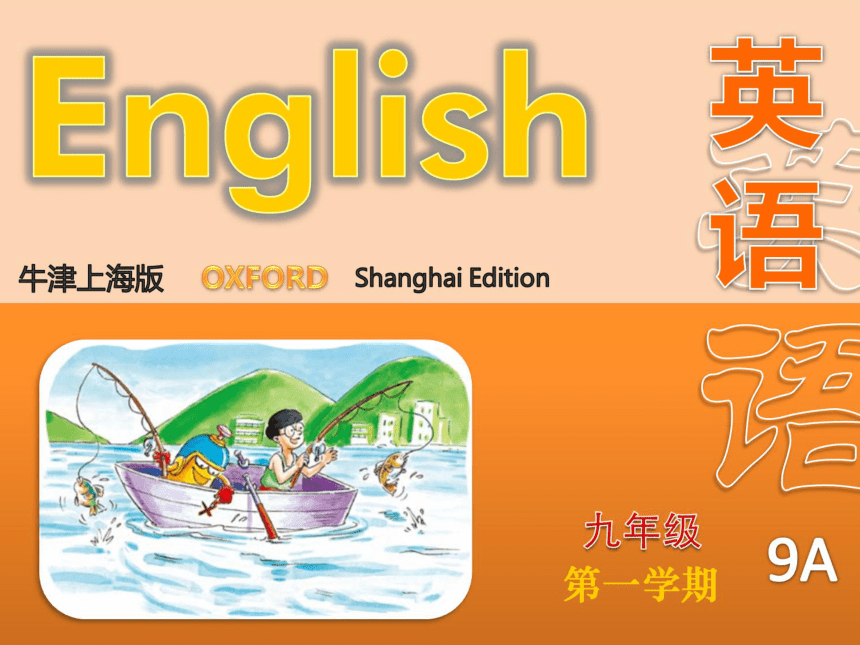 | |
| 格式 | zip | ||
| 文件大小 | 20.6MB | ||
| 资源类型 | 教案 | ||
| 版本资源 | 牛津上海版(试用本) | ||
| 科目 | 英语 | ||
| 更新时间 | 2016-06-21 23:47:15 | ||
图片预览



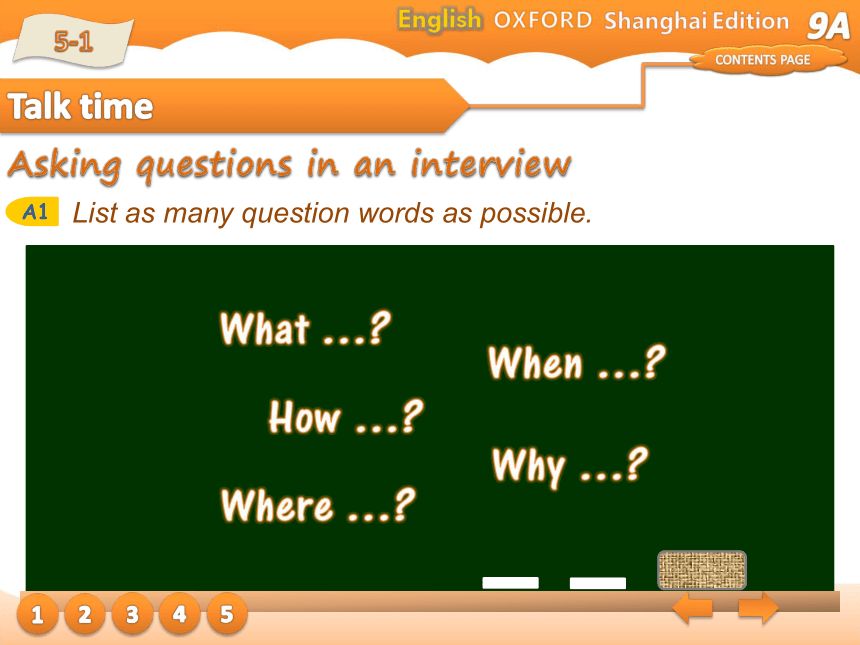

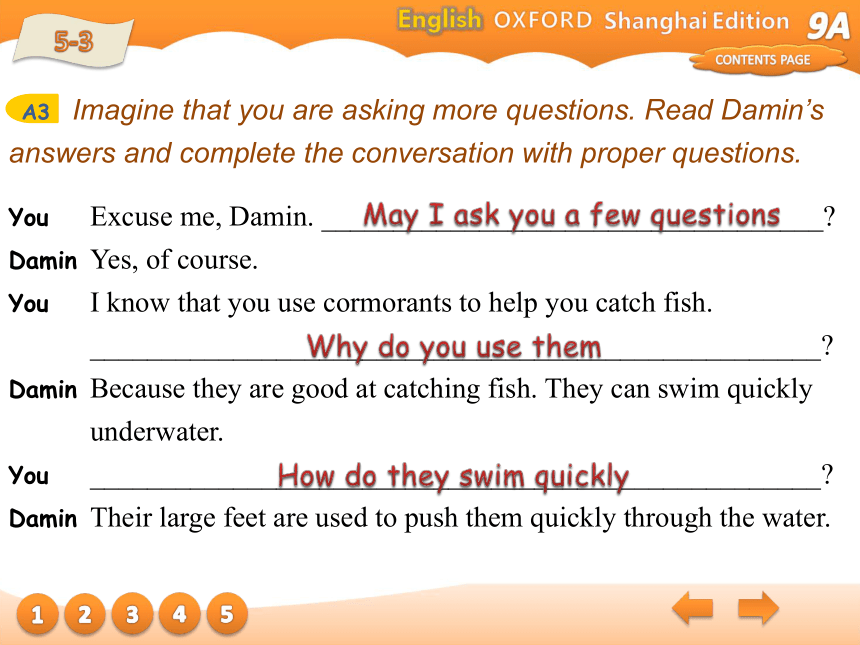
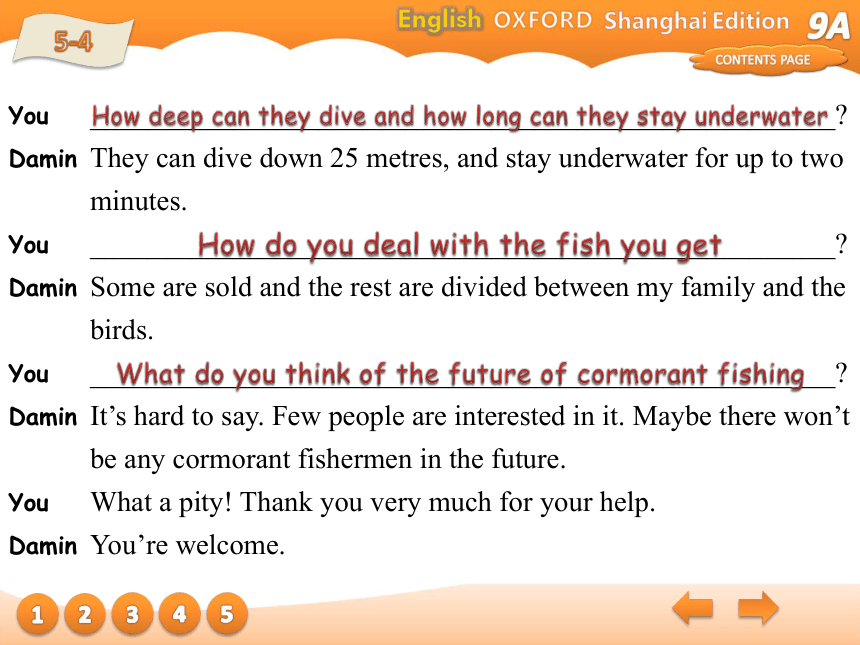

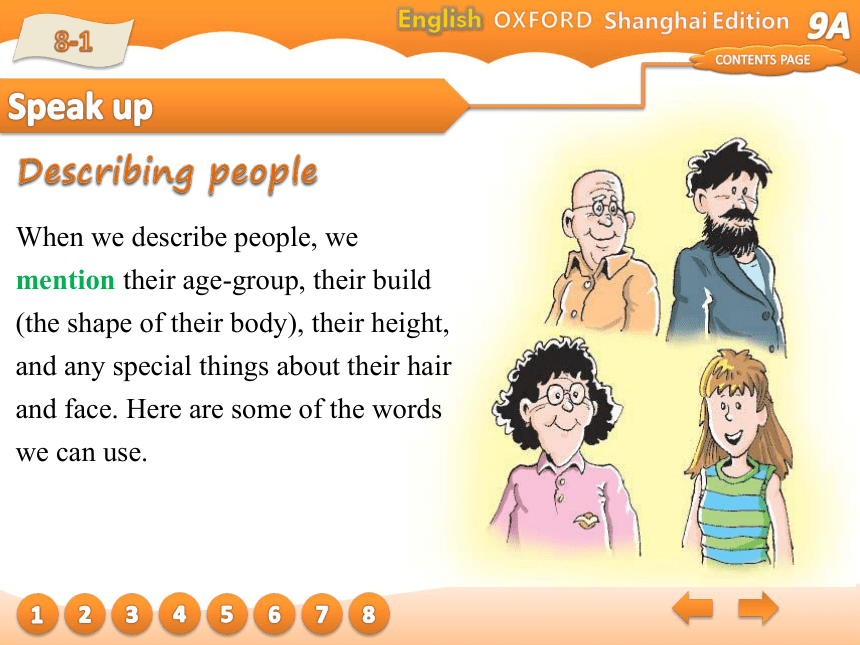
文档简介
课件21张PPT。1Myths,traditions and opinionsSpeaking2Traditional skillsCONTENTS PAGETalk timeSpeak upTalk time5-11234 List as many question words as possible.A1Asking questions in an interview5You Excuse me, Damin. Could you answer a few questions, please?
Damin Yes, certainly.
You (1)___________ cormorants have you got at the moment?
Damin Twelve.
You (2)___________ do you usually start fishing every day?
Damin In the late afternoon.
You (3)___________ do you do to make sure that the cormorants don’t swallow the fish?
Damin I tie a piece of grass around the neck of each bird.
You (4)___________ can you work in the darkness?
Damin I hang a light at the front of my raft.
You Thank you very much for your help.
Damin You’re welcome. Imagine that you are interviewing Damin. Complete the following conversation using suitable question words.A25-212345How manyWhenWhatHow Imagine that you are asking more questions. Read Damin’s answers and complete the conversation with proper questions.A35-312345You Excuse me, Damin. ___________________________________?
Damin Yes, of course.
You I know that you use cormorants to help you catch fish. ___________________________________________________?
Damin Because they are good at catching fish. They can swim quickly underwater.
You ___________________________________________________?
Damin Their large feet are used to push them quickly through the water.May I ask you a few questionsWhy do you use themHow do they swim quickly5-412345You ____________________________________________________?
Damin They can dive down 25 metres, and stay underwater for up to two minutes.
You ____________________________________________________?
Damin Some are sold and the rest are divided between my family and the birds.
You ____________________________________________________?
Damin It’s hard to say. Few people are interested in it. Maybe there won’t be any cormorant fishermen in the future.
You What a pity! Thank you very much for your help.
Damin You’re welcome.How deep can they dive and how long can they stay underwaterHow do you deal with the fish you getWhat do you think of the future of cormorant fishing You want to find out more about Damin. Think of more questions that you can ask Damin and make a list. Then role-play the interview with a partner.A45-512345Speak up8-1123Describing people4When we describe people, we mention their age-group, their build (the shape of their body), their height, and any special things about their hair and face. Here are some of the words we can use.56788-21234age-group
young
middle-aged
elderly
oldbuild
fat/plump
well-built
slim/thin
thinly-builtrefers to someone up to about 35
refers to someone up to about 60
refers to someone up to about 70
refers to someone above 75build means body size and shape
plump is a kinder word than fat
well-built means muscular
slim is a more flattering word than thin
thinly-built means slightly-built56788-31234height
tall
above average height
of average height
below average height
shorthair/face
black/blond(e)/red/curly/straight/long/short hair
bald
wears glasses
has a beard/moustachebeardmoustache56788-41234The following words are required for a complete description:wavy hair (less tight than curly)
full/thin lips
mole/beauty spot (dark spot on skin)
flat/pointy/sharp nose
double/single eyelids
high cheek bones
round/sharp/double chin
receding hair line
scar
dark/fair complexion5678 Work in pairs. S1 reads the descriptions below. S2 looks at the pictures and says who S1 is talking about.B18-5123412She’s plump, above average height, has long blonde hair, and wears sunglasses.He’s well-built, short and bald, and has a thick black moustache.5678 Work in pairs. Take turns to describe one of the people in the picture and ask your partner to guess which one you have described.B28-6123412345678 Work in pairs.B38-71234Situation: S1 is a police officer. S2 saw someone drop a ¥100 note in the street. That person then got into a taxi and was gone. S2 took the money to the police station. S1 is asking S2 to describe the person who dropped the note. S1 must ask questions and complete this table. S2 may imagine a person in your class and describe him/her to S1. S1 and S2 act out the scene in class. The class must guess who dropped the ¥100 note.B45678 Find a picture of someone from a magazine, stick it in your book and write a description of the person.*B58-812345678说 明
本册教材根据上海市中小学(幼儿园)课程改革委员会制订的课程方案和《上海市中小学英语课程标准(征求意见稿)》编写,供九年义务教育九年级第一学期试用。
本教材经上海市中小学教材审查委员会审查准予试用。
《英语(牛津上海版)》(试用本)
主 编:沃振华
原 作 者:P Etherton G McArthur P Leetch
改编人员:沃振华 朱维庭 李绍贤 施安吉 施志红
奚翠华 卢 璐 张 瑶
牛津大学出版社(中国)有限公司英语教材编写委员会
责任编辑:马芳芳 林 妍
插 图:K Y Chan 周允达
课件制作:卢 璐
支持学校:上海市市北初级中学mention/'men?n/ v.speak or write a little about somethingWhen Liz telephoned, she mentioned that she was going to buy a new car.straight/stre?t/ adj.with no curve or bendUse a ruler to draw a straight line.situation/?s??u?e??n/ n.the things that are happening in a certain place or at a certain timeSusan is in a difficult situation – she can’t decide what to do.imagine/??m???n/ v.make a picture of something in your mindCan you imagine life without electricity?
Damin Yes, certainly.
You (1)___________ cormorants have you got at the moment?
Damin Twelve.
You (2)___________ do you usually start fishing every day?
Damin In the late afternoon.
You (3)___________ do you do to make sure that the cormorants don’t swallow the fish?
Damin I tie a piece of grass around the neck of each bird.
You (4)___________ can you work in the darkness?
Damin I hang a light at the front of my raft.
You Thank you very much for your help.
Damin You’re welcome. Imagine that you are interviewing Damin. Complete the following conversation using suitable question words.A25-212345How manyWhenWhatHow Imagine that you are asking more questions. Read Damin’s answers and complete the conversation with proper questions.A35-312345You Excuse me, Damin. ___________________________________?
Damin Yes, of course.
You I know that you use cormorants to help you catch fish. ___________________________________________________?
Damin Because they are good at catching fish. They can swim quickly underwater.
You ___________________________________________________?
Damin Their large feet are used to push them quickly through the water.May I ask you a few questionsWhy do you use themHow do they swim quickly5-412345You ____________________________________________________?
Damin They can dive down 25 metres, and stay underwater for up to two minutes.
You ____________________________________________________?
Damin Some are sold and the rest are divided between my family and the birds.
You ____________________________________________________?
Damin It’s hard to say. Few people are interested in it. Maybe there won’t be any cormorant fishermen in the future.
You What a pity! Thank you very much for your help.
Damin You’re welcome.How deep can they dive and how long can they stay underwaterHow do you deal with the fish you getWhat do you think of the future of cormorant fishing You want to find out more about Damin. Think of more questions that you can ask Damin and make a list. Then role-play the interview with a partner.A45-512345Speak up8-1123Describing people4When we describe people, we mention their age-group, their build (the shape of their body), their height, and any special things about their hair and face. Here are some of the words we can use.56788-21234age-group
young
middle-aged
elderly
oldbuild
fat/plump
well-built
slim/thin
thinly-builtrefers to someone up to about 35
refers to someone up to about 60
refers to someone up to about 70
refers to someone above 75build means body size and shape
plump is a kinder word than fat
well-built means muscular
slim is a more flattering word than thin
thinly-built means slightly-built56788-31234height
tall
above average height
of average height
below average height
shorthair/face
black/blond(e)/red/curly/straight/long/short hair
bald
wears glasses
has a beard/moustachebeardmoustache56788-41234The following words are required for a complete description:wavy hair (less tight than curly)
full/thin lips
mole/beauty spot (dark spot on skin)
flat/pointy/sharp nose
double/single eyelids
high cheek bones
round/sharp/double chin
receding hair line
scar
dark/fair complexion5678 Work in pairs. S1 reads the descriptions below. S2 looks at the pictures and says who S1 is talking about.B18-5123412She’s plump, above average height, has long blonde hair, and wears sunglasses.He’s well-built, short and bald, and has a thick black moustache.5678 Work in pairs. Take turns to describe one of the people in the picture and ask your partner to guess which one you have described.B28-6123412345678 Work in pairs.B38-71234Situation: S1 is a police officer. S2 saw someone drop a ¥100 note in the street. That person then got into a taxi and was gone. S2 took the money to the police station. S1 is asking S2 to describe the person who dropped the note. S1 must ask questions and complete this table. S2 may imagine a person in your class and describe him/her to S1. S1 and S2 act out the scene in class. The class must guess who dropped the ¥100 note.B45678 Find a picture of someone from a magazine, stick it in your book and write a description of the person.*B58-812345678说 明
本册教材根据上海市中小学(幼儿园)课程改革委员会制订的课程方案和《上海市中小学英语课程标准(征求意见稿)》编写,供九年义务教育九年级第一学期试用。
本教材经上海市中小学教材审查委员会审查准予试用。
《英语(牛津上海版)》(试用本)
主 编:沃振华
原 作 者:P Etherton G McArthur P Leetch
改编人员:沃振华 朱维庭 李绍贤 施安吉 施志红
奚翠华 卢 璐 张 瑶
牛津大学出版社(中国)有限公司英语教材编写委员会
责任编辑:马芳芳 林 妍
插 图:K Y Chan 周允达
课件制作:卢 璐
支持学校:上海市市北初级中学mention/'men?n/ v.speak or write a little about somethingWhen Liz telephoned, she mentioned that she was going to buy a new car.straight/stre?t/ adj.with no curve or bendUse a ruler to draw a straight line.situation/?s??u?e??n/ n.the things that are happening in a certain place or at a certain timeSusan is in a difficult situation – she can’t decide what to do.imagine/??m???n/ v.make a picture of something in your mindCan you imagine life without electricity?
